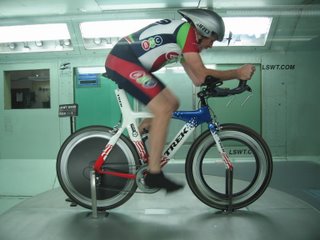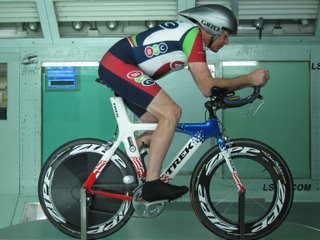Wind Tunnel Visit
On Thursday Chris Pulleyn, Jim Vance and I went to the San Diego Low Speed Wind Tunnel with one of the cyclists I coach to fine tune his time trial position. Chris is the bike fitter from Bicycle Ranch in Scottsdale, Ariz., I have worked with for the last several years. He has set the bikes for nearly every athlete I’ve coached since 2005. At least I think it was 2005 when we started working together. Regardless, it has been many years. Chris is thorough to a fault and always focused on perfection whether the rider is a novice or pro.
Dave Sanford met us at the front door of the tunnel and, as always, gave us a historical tour of the facility. It’s always an impressive sight seeing those big propeller blades. It’s called the “Low Speed” tunnel because the top end for the facility is a 275 miles per hour wind. That’s appropriate for airplanes and Cruise missiles but we would be operating at 25mph.
After the tour we set about getting the bike ready. Chris had already done a two-hour fit on it back in January. We were here now just to make small tweaks to the set up. I’ve found Chris’ fittings to be quite close when it comes to aerodynamics. So I knew we would only make small changes. That’s exactly how it turned out.
The first order of business involved installing an adjustable stem so that we could move the aerobars into several different configurations without changing stems each time. This saved a tremendous amount of time once we got started. And at $850 an hour, time is expensive.
Once the bike was ready and being mounted in the tunnel by Dave’s assistants, Chris, Jim, Dave, the rider and I talked over the procedure we would use. Here is the process we had decided on earlier:
Step 1. Baseline. Conduct a base run using the fit as Chris had originally set it back in January. The first picture here shows that set up. This would serve as the standard by which we would judge all subsequent runs. Each would last one minute once everything was up to speed — wind and rider — but with bike adjustments and getting the tunnel ready each time wound up taking about 10 minutes per run. Chris worked quickly between runs to make the adjustments that follow.
Step 2. Front end height. Once we had a baseline we would begin to tinker with base handlebar and stem height. We would start by lowering the bars 1cm. If that produced a positive result (lower coefficient of drag) we would try 2cm lower. Any other changes in bar height would depend on what we found.
Step 3. Aerobar extension angle. Next we would tinker with the angle of the aerobars and arms in the extended position by increasing the angle 5, 10 and 15 degrees upward on subsequent runs. Later we decided to also try lowering the bars 4 degrees below the base position which was at zero degrees. At this point we also decided to rotate inward the arm extension bars at the grip end.
Step 4. Head position and helmet. Once the front end was optimally set we would experiment with head positions and helmets. Early on, however, we decided that his head position was quite good so didn’t mess around with this. He had brought another aero helmet with him but when he tried it on it was such a poor fit, sitting well up on top of his head, that we decided not to do a run with it. We had early on decided to tape over the vents in the helmet to see what benefits we might get from that based on an earlier recommendation from John Cobb. Since he competes mostly in 20k and 40k time trials this is unlikely to produce a problem. For 40k TTs in the heat he may not tape the vents.
Step 5. Miscellaneous. If we still had time (we had booked two hours) we would try anything that seemed reasonable based on what we had seen in previous runs. As it worked out we tried only one additional change – extending the handlebar reach by 1cm.
Notice that we didn’t intend to make any adjustments to the saddle position. This is what determines power output and we were convinced that Chris had fit this just right back in January when he had used the Retul device to originally set the bike.
The second picture here is the best position we came up with which reduced his coefficient of drag from the baseline run of 0.283 to 0.278 – a 1.8% improvement which translated into a 20-second savings in time in a 40k TT. That’s a small (and expensive!) gain which just goes to show what a great job Chris did in setting his bike initially. This was the second time Chris and I had set a bike and then visited the tunnel with one of the athletes I coach. The last time we shaved off 75 seconds, but most of this was head position and helmet. So Chris is pretty darned accurate at bike fitting when it comes to aerodynamics.
The final changes we adopted for this rider based on the wind tunnel results were:
1. Handlebars lowered 1cm. While at 2cm lower he had better numbers he also became obviously more unstable so this was not a good investment as it would likely reduce power and increase fatigue. His core strength needs to improve and once it does we can probably drop the front end a bit lower.
2. Bar extensions and arms angled 10 degrees up. At both 5 and 15 degrees his drag increased. But interestingly, at 10 degrees he had less drag. Lowering the bar extensions four degrees below the base also increased his drag.
3. Rotated extension grips inward. This lowered his time by about five seconds.
4. Helmet vents taped over. This took off about five more seconds.
Labels: wind tunnel

